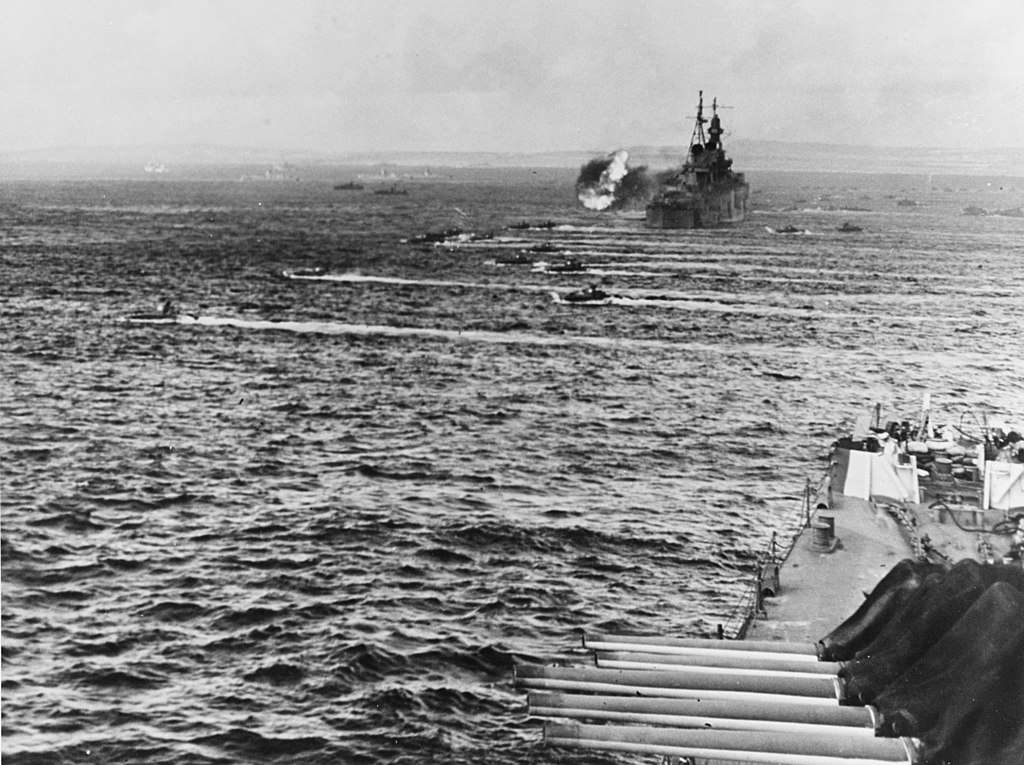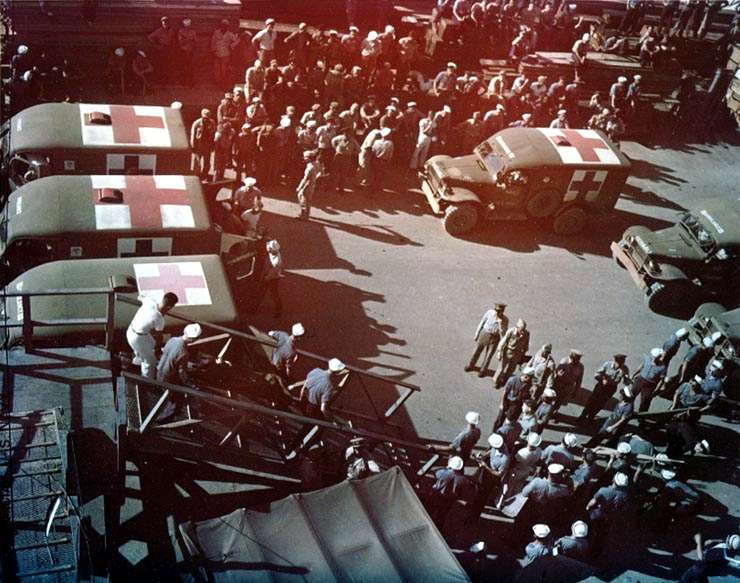The USS Indianapolis is arguably one of the most tragically famous ships in the history of the United States Navy.

This is the story of a World War II cruiser that delivered parts of the atomic bomb, only to be sunk shortly after, leading to one of the worst naval disasters in US history.
The USS Indianapolis
The USS Indianapolis, commissioned in 1932, was a Portland-class heavy cruiser.
Named for the city of Indianapolis, Indiana, the vessel was an embodiment of naval power and technological advancement for its time.
 USS Indianapolis entering the Hudson River, 1934.
USS Indianapolis entering the Hudson River, 1934.
With a displacement of 9,800 tons and armed with an array of formidable weaponry, including fifteen 6-inch guns, eight 5-inch guns, and numerous anti-aircraft guns, the cruiser was well-equipped for the battles it would encounter during the Second World War.
In the initial years following its commissioning, the Indianapolis served primarily as a vessel for diplomatic missions, carrying President Franklin D. Roosevelt on Good Neighbor policy trips throughout the 1930s.
 Franklin D. Roosevelt aboard the Indianapolis in Trinidad.
Franklin D. Roosevelt aboard the Indianapolis in Trinidad.
However, as World War II broke out, the cruiser transitioned from a ship of diplomacy to a ship of war, becoming an integral part of the U.S. Navy’s Pacific Fleet.
The Indianapolis first sailed into battle in the Pacific theatre in February 1942, engaging in combat operations during the Solomon Islands campaign and the Aleutian Islands campaign.
Here, it displayed its offensive prowess by providing gunfire support for landing troops and combating enemy ships and aircraft.
One of the most notable operations that the Indianapolis was involved in was the invasion of Iwo Jima in February 1945.
During this pivotal battle, the cruiser’s guns shelled Japanese positions, providing essential cover for the Marines as they stormed the beaches.
 USS Indianapolis firing on Saipan, 15 June 1944.
USS Indianapolis firing on Saipan, 15 June 1944.
Similarly, in the Battle of Okinawa, the Indianapolis played a significant role in bombarding Japanese fortifications.
The Fateful Mission
In July 1945, the USS Indianapolis was tasked with a top-secret mission that would drastically affect the trajectory of World War II.
This mission, known as Operation Little Boy, involved transporting the core of the atomic bomb ‘Little Boy’ from San Francisco to Tinian Island in the Mariana Islands.
The Indianapolis set sail from the Hunters Point Naval Shipyard, San Francisco, carrying the precious and potentially devastating cargo.
Unknown to most of the crew, the ship’s holds contained parts of the world’s first operational atomic bomb.
The components included uranium-235, a rare isotope and the key ingredient for the nuclear fission chain reaction.
Commanded by Captain Charles McVay III, the Indianapolis traversed the Pacific at a breakneck speed, setting a speed record by covering the distance in just ten days.
 Starboard view of the USS Indianapolis.
Starboard view of the USS Indianapolis.
This speed was essential to ensure the bomb’s components were delivered promptly, as American commanders were keen to end the war swiftly to minimize further casualties.
Upon reaching Tinian Island on July 26, the critical components were offloaded and later assembled into what would become the first atomic bomb used in warfare, dropped on Hiroshima.
Following the successful delivery, the Indianapolis was directed towards Leyte, an island in the Philippines, where it was supposed to take part in training exercises.
Throughout this mission, the crew performed their duties with dedication, oblivious of the tremendous significance their cargo held.
This mission’s completion marked a turning point in the war, though at the time, the crew couldn’t have understood the role they played in history.
Their journey across the Pacific, carrying the weapon that would ultimately lead to the end of the war, was only the beginning of a series of events that would lead to one of the most catastrophic naval disasters in U.S. history.
Their next leg to the Philippines would set the stage for an unimaginable tragedy.
The Attack On The Indianapolis
As the USS Indianapolis set course for the Leyte Gulf in the Philippines after successfully completing its crucial mission, it was unwittingly heading towards peril.
The ship, unbeknownst to the crew and her commander, was sailing into the hunting grounds of the Japanese submarine I-58, under the command of Mochitsura Hashimoto.
On the fateful night of July 30, 1945, the sea was calm and the visibility limited due to a partly cloudy sky.
The Indianapolis, cruising unescorted, was oblivious to the danger lurking beneath the dark Pacific waters.
At 14 minutes past midnight, the I-58’s torpedoes found their mark.
The Japanese submarine, equipped with six torpedo tubes and a Type 95 torpedo — one of the most potent torpedoes of World War II — launched a lethal spread of torpedoes towards the unsuspecting Indianapolis.
Two of them struck the cruiser on her starboard side.
 USS Indianapolis at Pearl Harbor in 1937.
USS Indianapolis at Pearl Harbor in 1937.
The first torpedo hit the bow, causing a massive explosion that sent shockwaves throughout the ship.
The impact blew off around 65 feet of the ship’s bow, instantly killing numerous crew members and spreading fires across the decks.
The second torpedo struck shortly after, closer to midship, near a fuel tank and a powder magazine.
This explosion was even more destructive, igniting aviation fuel and munitions, tearing open the ship’s hull, and causing catastrophic flooding.
The Indianapolis, critically damaged and rapidly taking on water, listed severely. The order to abandon ship was given, but the severity and suddenness of the attack left little time for the crew to react.
Life rafts and flotation devices were limited, and many men were forced into the shark-infested waters with little more than life vests or debris to keep them afloat.
In just twelve minutes after the initial torpedo strike, the once-proud warship slipped beneath the waves, taking with her around 300 of her crew.
Why did thеy blamе thе captain of thе USS Indianapolis?
Captain McVay was initially blamеd for not using zigzag tactics, but this wouldn’t havе prеvеntеd thе submarinе attack.
Thе disastеr rеsultеd from many mistakеs likе not sеnding a distrеss signal, inadеquatе training, lack of еscort, and unawarеnеss of еnеmy submarinеs.
Latеr, thеy clеarеd McVay’s namе, and focusеd on fixing thе largеr problеms bеhind thе tragеdy.
The Aftermath
Following the swift and brutal sinking of the USS Indianapolis, approximately 900 sailors and Marines were left stranded in the shark-infested waters of the Pacific Ocean.
The initial shock of the sinking gave way to a desperate fight for survival, marred by a series of unfathomable challenges that the survivors had to endure.
The men were scattered over a large area, with only a few life rafts available and many clutching onto floating wreckage.
Some were fortunate to have kapok life jackets, but these flotation aids were designed to provide buoyancy for only a short period and slowly absorbed water over time.
For many, their only hope for survival was their determination and sheer willpower.
The survivors battled exposure, dehydration, and exhaustion, their bodies succumbing to the elements.
They were exposed to the unforgiving sun during the day, with no shade or respite, leading to severe sunburns and heatstroke.
At night, they suffered from hypothermia as temperatures dropped.
Lack of drinkable water further intensified their suffering. Some men, driven by extreme thirst, succumbed to the temptation of drinking seawater, which led to a detrimental condition known as hypernatremia.
The high salt content of the seawater further dehydrated the body and led to mental confusion, hallucinations, and in many cases, death.
Among these grim conditions lurked a more immediate and terrifying threat – sharks.
Attracted by the sound of the explosion, the blood and bodies in the water, and the thrashing of survivors, shark attacks became a horrifyingly regular occurrence.
Oceanic whitetip sharks and tiger sharks, known for their aggression, started preying on the survivors, picking off men one by one.
The delay in rescue, due to a combination of bureaucratic failure and miscommunication, meant that the stranded sailors were left to fend for themselves in these brutal conditions for four horrific days and five nights.
It was only on August 2, almost four and a half days after the sinking, that the survivors were accidentally discovered by Lieutenant Wilbur Gwinn, piloting a PV-1 Ventura bomber on a routine patrol flight.
By the time the rescue operations were completed on August 3, only 316 men out of the approximately 900 who initially survived the sinking were still alive.
The rest had perished due to a combination of injuries from the initial sinking, exposure, dehydration, saltwater poisoning, and shark attacks.
 Survivors placed in ambulances after being brought ashore.
Survivors placed in ambulances after being brought ashore.
The Tragedy Unveiled
The sinking of the USS Indianapolis and the delayed rescue of its crew were the results of a cascade of errors, miscalculations, and systemic failures that occurred both before and after the attack.
These failures not only contributed to the disaster but also exacerbated its consequences.
One major failure was the lack of a distress signal from the Indianapolis. Though the ship was equipped with cutting-edge technology, the suddenness and severity of the attack didn’t allow for an SOS to be sent.
The inability to communicate their desperate situation left the crew isolated in the vast Pacific.
Additionally, when the Indianapolis did not arrive at Leyte as scheduled, and no distress signal was received, no immediate action was taken by naval authorities.
The standard operating procedures at the time did not require an immediate search for a missing vessel.
As such, the disappearance of the Indianapolis did not raise the necessary alarms, contributing to the delay in rescue efforts.
 Survivors aboard a landing craft being taken ashore to Peleliu.
Survivors aboard a landing craft being taken ashore to Peleliu.
Perhaps most critically, the USS Indianapolis was not warned of the potential presence of Japanese submarines along its route.
Although naval intelligence had intercepted Japanese transmissions that suggested submarine activity in the cruiser’s path, this information was not relayed to the Indianapolis or its escort vessels.
The ship sailed unknowingly into dangerous waters, resulting in its catastrophic encounter with the I-58.
Post-disaster investigations revealed further systemic failures.
Three separate stations received signals of the submarine attack on the Indianapolis, but all of them were either ignored or mishandled due to various reasons, including disbelief in the message’s authenticity and procedural errors.
The absence of a convoy escort for the Indianapolis during its transit to Leyte was another crucial failure.
Traditionally, warships like the Indianapolis were assigned destroyer escorts, especially when traversing submarine-infested waters.
However, in this case, the Indianapolis was not provided with an escort, leaving it vulnerable to submarine attacks.
Lastly, the men were not adequately trained or equipped for such a disaster.
While it’s true that no amount of training could fully prepare the crew for the catastrophe they faced, better survival gear and more extensive disaster preparedness could have reduced the number of casualties.
The systemic failures that marked the ordeal of the USS Indianapolis extended beyond the sinking itself, adding to the tragedy.
They highlight the importance of effective communication, robust procedures, and thorough training in mitigating the effects of such catastrophes.
The sinking of the Indianapolis is a stark reminder of the grave consequences when these systems fail.